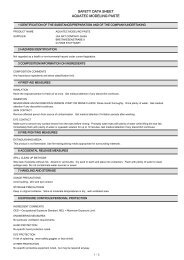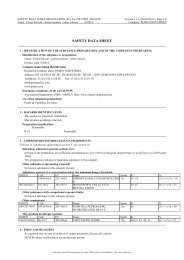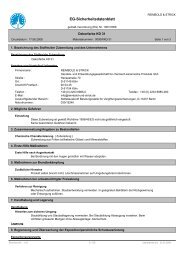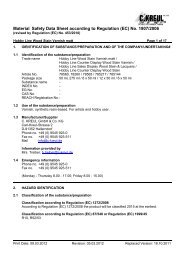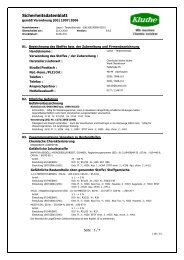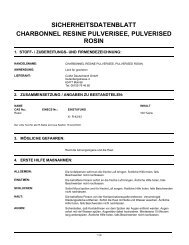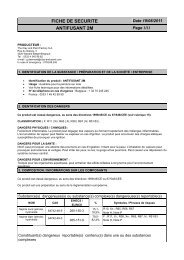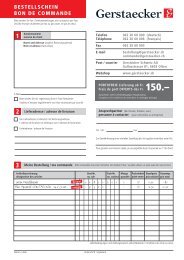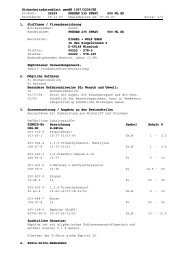safety data sheet lefranc & bourgeois essence d'aspic ... - Kreativ.de
safety data sheet lefranc & bourgeois essence d'aspic ... - Kreativ.de
safety data sheet lefranc & bourgeois essence d'aspic ... - Kreativ.de
Create successful ePaper yourself
Turn your PDF publications into a flip-book with our unique Google optimized e-Paper software.
Process conditions<br />
LEFRANC & BOURGEOIS ESSENCE D'ASPIC / OIL OF SPIKE LAVENDER<br />
Provi<strong>de</strong> eyewash station. Use engineering controls to reduce air contamination to permissible exposure level.<br />
Engineering measures<br />
Provi<strong>de</strong> a<strong>de</strong>quate ventilation, including appropriate local extraction, to ensure that the <strong>de</strong>fined occupational exposure limit is not excee<strong>de</strong>d.<br />
Respiratory equipment<br />
If ventilation is insufficient, suitable respiratory protection must be provi<strong>de</strong>d.<br />
Hand protection<br />
For prolonged or repeated skin contact use suitable protective gloves. Nitrile gloves are recommen<strong>de</strong>d.<br />
Eye protection<br />
Use eye protection.<br />
Hygiene measures<br />
SDS No. 12565<br />
Use appropriate skin cream to prevent drying of skin. Promptly remove non-impervious clothing that becomes wet or contaminated. No specific<br />
hygiene procedures noted, but good personal hygiene practices are always advisable, especially when working with chemicals.<br />
SECTION 9: PHYSICAL AND CHEMICAL PROPERTIES<br />
9.1. Information on basic physical and chemical properties<br />
Appearance<br />
Liquid<br />
Colour<br />
Light (or pale).<br />
Odour<br />
Characteristic.<br />
Solubility<br />
Insoluble in water<br />
Relative <strong>de</strong>nsity 0, 880-0, 905<br />
Vapour pressure<br />
175-300 kPa<br />
Flash point<br />
51 CC (Closed cup).<br />
9.2. Other information<br />
SECTION 10: STABILITY AND REACTIVITY<br />
10.1. Reactivity<br />
10.2. Chemical stability<br />
10.3. Possibility of hazardous reactions<br />
10.4. Conditions to avoid<br />
10.5. Incompatible materials<br />
10.6. Hazardous <strong>de</strong>composition products<br />
During fire, toxic gases (CO, CO2, NOx) are formed.<br />
SECTION 11: TOXICOLOGICAL INFORMATION<br />
11.1. Information on toxicological effects<br />
Toxicological information<br />
No information available.<br />
General information<br />
Contains small amounts of organic solvents. Extensive use of the product in areas with ina<strong>de</strong>quate ventilation may result in hazardous vapour<br />
concentrations.<br />
Inhalation<br />
May cause irritation to the respiratory system. Vapours may cause headache, fatigue, dizziness and nausea.<br />
Skin contact<br />
Product has a <strong>de</strong>fatting effect on skin. Prolonged contact may cause redness, irritation and dry skin.<br />
Eye contact<br />
May cause temporary eye irritation.<br />
SECTION 12: ECOLOGICAL INFORMATION<br />
4 / 6







